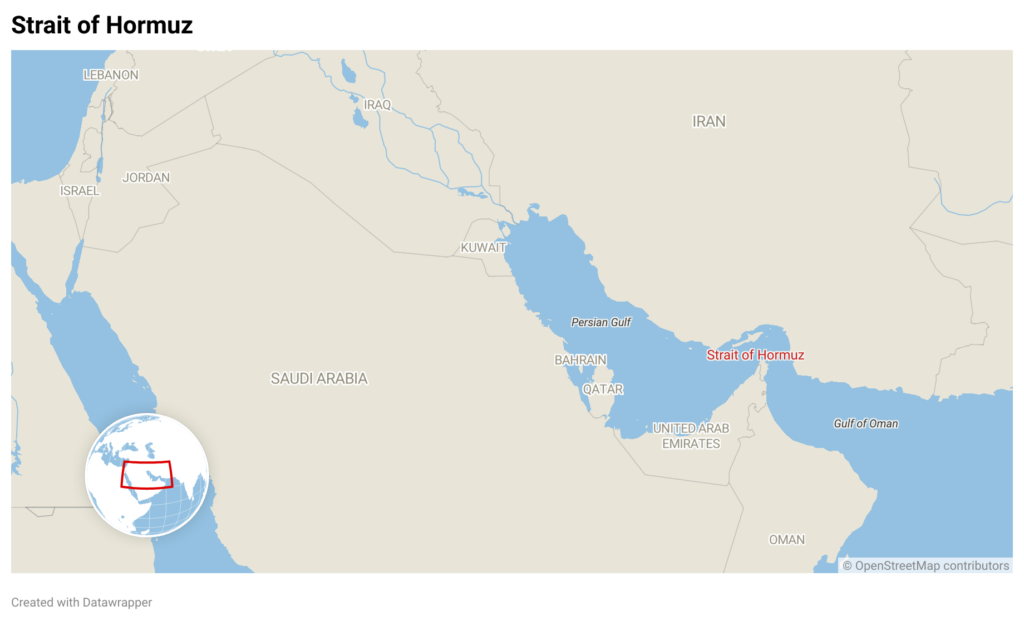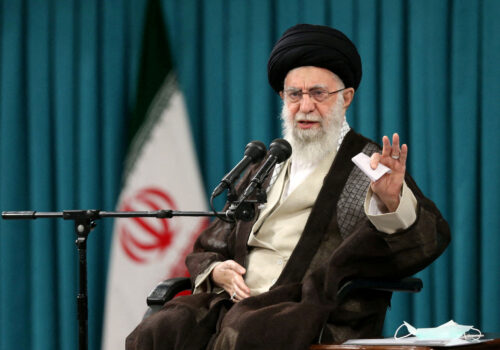Four questions (and expert answers) about Iran’s threats to close the Strait of Hormuz
On Monday, Iran launched a volley of missiles at a US military base in Qatar. The strikes were in retaliation for the US bombing of three Iranian nuclear sites over the weekend. It is not yet clear if that will be the end of Iran’s response, but if Tehran believes the retaliation needs to be even stronger, among its options is to try to close the Strait of Hormuz. Just twenty-one miles wide at its narrowest point, the strait is a critical global energy artery, through which around 20 percent of the world’s oil consumed each year transits. On Sunday, Iranian media reported momentum was building in the country’s parliament to close the strait, though a formal decision had not been made. What would it take for Iranian forces to shut down this critical waterway? How would doing so impact the region and beyond? Below, Atlantic Council experts answer four pressing questions.
1. How could Iran potentially close the Strait of Hormuz?
Following the missiles it launched at the US air base on Monday, Iran could choose to double down on its attacks against US forces in the Middle East, or it could turn to diplomacy. But Iran could also choose a middle ground by attempting to disrupt shipping through the Strait of Hormuz, as Tehran did during the tanker war of 1984 to 1988. If Iran were to pursue this path, it has the capability to inflict consequential economic disruption to the world economy.
Iran possesses approximately five thousand to six thousand naval mines, according to US intelligence estimates. Iran has the capability to deploy large quantities of these mines in the narrow passage of the Strait of Hormuz shipping lane. Immediate deployment could occur via Iran’s roughly twenty-five submarines. This fleet reportedly includes three Russian Kilo-class vessels and around twenty-three domestically produced Ghadir-class mini-submarines. Even the threat of Iranian mines has the potential to halt commercial traffic within days.
More directly, Iran fields a coastal defense network with anti-ship missiles that could cover the extent of the strait and easily damage unarmed tankers. These systems include the Khalij-e Fars ballistic missiles (with a range of 300 kilometers), Hormuz-1 and Hormuz-2 missiles with active/passive radar seekers (300-kilometer range), and C-802 Noor cruise missiles (120-kilometer range).
Additionally, Iran’s arsenal of unmanned aerial vehicles (UAVs) has been employed against shipping in the past. Even if only half of Iran’s UAV arsenal were left, the numbers would reach a few thousand. Given the effective use of these UAV designs by Russia and the Houthis, they could prove an immediate threat to shipping in the strait. The threat of Iranian UAVs across the region helps explain the continued Israeli strikes against Iranian UAV storage and launch sites.
With thousands each of naval mines, attack UAVs, and missiles in its arsenal, Iran has the capacity to disrupt shipping in the Strait of Hormuz. But in the face of a determined US response, Iran is not capable of completely closing the strait.
—Daniel E. Mouton is a nonresident senior fellow at the Scowcroft Middle East Security Initiative of the Atlantic Council’s Middle East Programs. He served on the National Security Council from 2021 to 2023 as the director for defense and political-military policy for the Middle East and North Africa for Coordinator Brett McGurk.

2. What would closing the Strait of Hormuz mean for energy trade and the global economy?
“Closing” the Strait of Hormuz is not as simple as it sounds. The waterway is just twenty-one miles wide at its narrowest point, and even though the currently recognized Traffic Separation Scheme takes vessels up against Iranian waters, there are other navigable paths. It would be nearly impossible for Iran to fully block all shipping traffic into and out of the Strait of Hormuz on its own with its current capabilities. However, there are various ways that Iran could intimidate or harass ships that would rile or disrupt global energy markets.
In 2024, just over twenty million barrels per day of petroleum liquids (crude oil, condensate, and petroleum products) flowed through the Strait of Hormuz, according to the US Energy Information Administration. This amounted to about 20 percent of global consumption. Saudi Arabia transports the most crude oil of any country through the Strait of Hormuz at 5.5 million barrels per day. The waterway is also a vital thoroughfare for liquefied natural gas (LNG), with Qatar exporting between 10.3 billion and 11.5 billion cubic feet per day of LNG, or about one-fifth of the global LNG trade. Over 80 percent of the crude oil, condensate, and LNG transported through the Strait of Hormuz is consumed in Asian markets—specifically China, India, Japan, and South Korea.
Any shipping disruptions in the Strait of Hormuz would have a faster and more intense impact on Asian economies and Asian markets. These areas would see higher prices along with a high likelihood for gasoline, diesel, and jet fuel shortages. Governments would likely implement rationing policies. Economic activity would slow as a result. Higher energy prices would impact the price of oil globally, so even regions that don’t rely on oil from the Persian Gulf would see higher prices.
Iran could also impact global energy markets without actually obstructing shipping, simply by harassing vessels or firing missiles in the vicinity of shipping traffic. This threat of danger would alarm insurance companies, which would then raise insurance rates for travel through the strait. Shipping companies, too, would charge more for cargoes originating in the Persian Gulf. As news of attacks spread, prices would likely spike. This would lead to highly unstable oil prices for a period of time, until the source of the threats was naturalized or the market comes to see the Iranian activity as the new status quo. This scenario seems most likely because it would cause a nuisance and various headaches for oil exports and shipping companies while not actually impeding supply and giving Gulf countries a reason to turn against Iran. Additionally, Iranian ships could continue to export Iranian oil, thus generating cash for the regime.
—Ellen R. Wald is a nonresident senior fellow with the Atlantic Council Global Energy Center and the president of Transversal Consulting.
***
Iran’s parliament may support closing the Strait of Hormuz, but markets aren’t reacting with panic—and for good reason. While the instinct is to assume some kind of disruption is imminent, the reality is more complex and, for now, relatively stable.
China—not the West—is disproportionately exposed to any Iranian move in the strait. That puts significant pressure on Supreme Leader Ali Khamenei—the person with ultimate authority to act in this moment—from a critical ally not to escalate. More importantly, closing Hormuz would cripple Iran’s own economy. The strait is its primary revenue artery; shutting it would be an act of self-sabotage.
Meanwhile, US producers could benefit. Even the threat of disruption allows firms to hedge at higher prices, supporting increased upstream activity and reinforcing US energy dominance. What hurts Iran may end up boosting US output.
That said, in the unlikely event that Iran takes concrete steps to close the strait, markets will focus on two variables: the scale and duration of the disruption. Much like the 2019 attacks on Saudi Arabia’s Abqaiq oil facilities, where the swift Saudi response stabilized global flows, a decisive US military or diplomatic intervention could keep markets steady. If Washington can quickly and credibly restore freedom of navigation, the oil market’s initial volatility would likely be short-lived.
In this moment, Tehran risks overplaying its hand and triggering a backlash that leaves it further economically and diplomatically isolated. The vote in Iran’s parliament may grab headlines, but the fundamentals remain intact. The world won’t ignore an Iranian provocation in the strait—but it won’t collapse over it either.
—Landon Derentz is the Atlantic Council’s vice president for energy and infrastructure as well as senior director of the Global Energy Center. He previously served as director for Middle Eastern and African affairs at the US Department of Energy.
3. How might Gulf states react?
The Arab Gulf states have invested heavily in diversification strategies that seek to reorient their economies away from reliance on oil and gas. While those efforts have seen success, with the United Arab Emirates (UAE) and Bahrain scoring highest in the Gulf Cooperation Council in the 2025 Economic Diversification Index, the escalating conflict with Iran will demonstrate those countries’ continued sensitivity to energy market volatility. In the event Iran were to follow through on its threat to close the Strait of Hormuz, the UAE and Saudi Arabia, in particular, have alternate pipeline options to fall back on (albeit with limited capacity). Their positioning as global financial and tech leaders, on the other hand, relies heavily on continued geopolitical and economic stability in the Middle East. This reality has driven those countries in recent years to thaw relations with Iran. Where in the past they may have cheered actions like the US strikes against Iranian nuclear facilities, instead they issued condemnations of varying degrees of intensity as a conflict initially confined to Israel and Iran threatens to spill over into the rest of the region.
In the days ahead, the Gulf countries will have two primary diplomatic goals: to insulate themselves from whatever additional kinetic retaliation Iran may now be planning and to urgently seek de-escalation by both Iran and the United States in order to protect the continued viability of economic models that rely on reliable and safe movement of people and goods. The Strait of Hormuz is central to that—the Gulf states will therefore seek to convince Iran that a closure is self-defeating and risks jeopardizing the regime’s hard-won improved relations with its neighbors.
—Jennifer Gavito is a nonresident senior fellow with the Scowcroft Middle East Security Initiative within the Atlantic Council’s Middle East Programs. She previously served as deputy assistant secretary of state for Iraq and Iran.
4. What would it take to reopen the strait?
If Iran were to attempt to close the Strait of Hormuz, the Reagan administration’s Operation Earnest Will provides the blueprint for responding to Iran. The largest naval convoy operation since World War II, Operation Earnest Will began with difficulties. Although US naval escorts were sufficient to deter direct Iranian attacks, the first convoy passage saw the tanker Bridgeton strike an Iranian mine. This mine strike exposed a capability gap whereby the US Navy lacked sufficient mine-warfare capability in the region.
The Reagan administration responded with a large force deployment that included over thirty warships in addition to mine-warfare helicopters and minesweepers. Special operations forces converted two oil service barges into mobile sea bases for forward operations against mobile Iranian naval forces. When Iran continued mining operations, which severely damaged the USS Samuel B. Roberts, the United States launched Operation Praying Mantis and subsequently destroyed Iran’s mine-warfare-associated naval facilities and vessels.
The current conditions are more complex, as Iran possesses not only thousands of naval mines but also a variety of other systems, such as UAVs and missiles that Iran could use against shipping. Thus, a US response would require sufficient mine sweepers to clear the strait but would also require additional capability, likely including air defense and escort warships for convoys transiting the strait.
Operation Earnest Will and the associated Operation Praying Mantis showed that a considerable deployment of military and naval capability, and a willingness to strike Iran, make it feasible to reopen the Strait of Hormuz against a determined effort to disrupt traffic through it.
—Daniel Mouton
Further reading
Sat, Jun 14, 2025
Israel’s Iran strike provides a historic chance for Middle East realignment
Inflection Points By Frederick Kempe
History will remember this moment less for the Israeli strikes themselves and more for what follows.
Sun, Jun 22, 2025
Trump made the right call. Will Khamenei do the same?
New Atlanticist By William F. Wechsler
The Iranian regime is in a fundamentally weak position, and it should leap at this last opportunity to save itself.
Sat, Jun 21, 2025
Experts react: The United States just bombed Iran’s nuclear sites. Here’s what to expect next.
New Atlanticist By
Early on Sunday morning in the Middle East, US forces targeted Fordow, Natanz, and Isfahan. Atlantic Council experts survey the fallout for Iran and for the region.
Image: Oil tankers pass through the Strait of Hormuz, December 21, 2018. REUTERS/Hamad I Mohammed/File Photo



